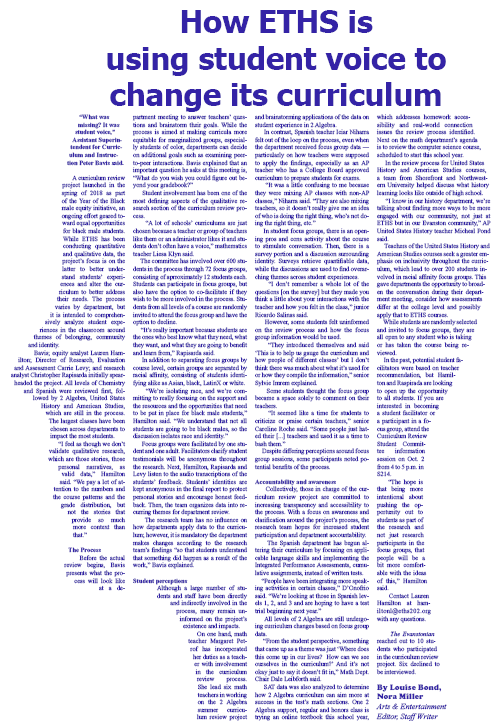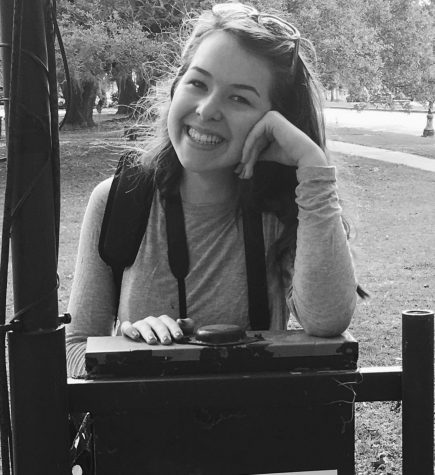How ETHS is using student voice to change its curriculum
September 27, 2019
“What was missing? It was student voice,” Assistant Superintendent for Curriculum and Instruction Peter Bavis said.
Beginning in the spring of 2018, a new curriculum review project was launched as part of the Year of the Black male equity initiative, which is an ongoing effort geared toward equal opportunities for black male students. While the school has been conducting both quantitative and qualitative data to inform this process, the focus is on the latter, to better understand students’ experiences. In the courses being reviewed, this data is used to alter the curriculum to better address their needs. The process varies with each department, but it’s always intended to provide a comprehensive analysis of student experience in the classroom, centered around the themes of belonging, community, and identity.
The project was initially spearheaded by Bavis; equity analyst Lauren Hamilton; research analyst Christopher Rapisarda and Director of Research, Evaluation and Assessment Carrie Levy. The first two courses to be reviewed were are all levels of Chemistry and Spanish, followed by 2 Algebra and US History/American Studies, which are both still in process. Courses to review have been chosen thus far with the intention of reaching different departments and focusing on their classes with the highest enrollment to impact the greatest number of students.
“I feel as though we don’t validate qualitative research, which are those stories, those personal narratives, as valid data. We pay a lot of attention to the numbers and the course patterns and the grade distribution, but not the stories that provide so much more context than that,” Hamilton said.
The Process
Prior to the actual review process, Bavis leads an initial presentation at one of the mandatory department meetings of what the process will look like to answer teachers’ questions and brainstorm their goals. Bavis said an important question he always asks the teachers at this meeting is, “What do you wish you could figure out beyond your gradebook?”
The process is always aimed at making curricula for each course more equitable for all marginalized groups in the school, especially students of color, but additional goals are decided by departments. Goals can include the amount of interaction students are having with their peers or the level students feel challenged on an everyday basis.
A timeline for when the focus groups will be held and the reporting of the findings is given at these initial meetings.
Student involvement has been one of the most defining aspects of the qualitative research section of the curriculum review process.
“A lot of schools’ curriculums are just chosen because a teacher or group of teachers like them or an administrator likes it, and students don’t often have a voice,” mathematics teacher Liesa Klyn said.
The committee has involved over 600 students in the process through 72 focus groups, usually consisting of about 12 students each. Students can not only participate in focus groups, but also have the option to co-facilitate if they wish to be a bigger part of the process.
“It’s really important because students are the ones who best know what they need, what they want and what they are going to benefit and learn from,” Rapisarda said.
Students from class rosters of all levels of the course are randomly chosen and invited to attend the focus group. They are given the option to decline, but are excused from that class on one day to participate if they agree. Multiple focus groups, with different students each time, are held over the course of about a week throughout most periods of the day.
In addition to separating the focus groups by course level, certain groups are separated by racial affinity, consisting of students identifying alike as Asian, black, LatinX or white. As many of the questions students are asked imply issues surrounding identity, affinity groups were made to cultivate a safe space for students to share their true experience in the class.
“We’re isolating race, and we’re committing to really focusing on the support and the resources and the opportunities that need to be put in place for black male students,” Hamilton said. “We understand that not all students are going to be black males, so the discussion isolates race and identity.”
The majority of focus groups are held in either the Hub or the reading room in East Library. There is usually one student facilitator at each focus group and one adult. Facilitators clarify that anonymity will be granted to their testimonials throughout the research.
Next, Hamilton, Rapisarda and Levy, who make up the research team for this project, listen to the audio transcriptions of the student’s feedback. They are the only ones who listen to the audio, and students’ identities are kept anonymous in the final report to protect personal stories and encourage honest feedback. Then, the data is organized into recurring themes for the department to review.
The research team has no influence on how departments use the data in the curriculum of the course; however, it is mandatory that the department makes some sort of change according to the research team’s findings “so that students understand that something did happen as a result of the work,” Bavis explained.
Student/Teacher Perceptions
Even though a large number of students and staff have been directly and indirectly involved in the process, many remain uninformed on the project’s existence and impacts.
On one side of the spectrum, math teacher Margaret Petrof utilized her knowledge as a teacher in the curriculum review process. She was the leader of a group of six math teachers who worked on the 2 Algebra summer curriculum review project to brainstorm applications of the data they got on student experience in 2 Algebra.
On the other hand, Spanish teacher Iciar Niharra felt like she was out of the loop on the process, even when the department received the data after the focus groups–particularly on how teachers were supposed to apply the findings, especially as an AP teacher that has a College Board approved curriculum to prepare for an exam at the end of the year.
“It was a little confusing to me because they were mixing AP classes with non-AP classes,” Niharra said. “They are also mixing teachers, so it doesn’t really give me an idea of who is doing the right thing, who’s not doing the right thing, etc.”
While some teachers initially think so, the curriculum review process does not evaluate them, just the course itself.
In the student focus groups, there is an opening pros and cons activity about the course to stimulate conversation. Then, there is a survey portion and a discussion surrounding identity. Surveys retrieve quantifiable data, while the discussion is used to find overarching themes in student experience.
“I remember I was listening when they were talking about the amount of homework given,” said Salinas. “I don’t remember a whole lot of the questions [on the survey], but they made you think a little about your interactions with the teacher and how you felt in the class.”
However, some students felt uninformed on the review process and how the focus group information would be used.
“They introduced themselves and said, ‘This is to help us gauge the curriculum,’ but I don’t think there was much about what it’s used for or how they compile the information,” senior Sylvie Imrem explained.
Other students thought that the focus group space became a space solely to comment on their teachers.
“It seemed like a time for students to criticize or praise certain teachers,” senior Caroline Roche said. “Some people just hated their […] teachers and used it as a time to bash them.”
Despite differing perceptions around focus group sessions, some participants noted potential benefits of the process.
“I think that it can be really good for the school [to get] the student’s feedback when designing curriculum and adjusting curriculums,” Imrem explained.
Accountability/Awareness/Accessibility
Collectively, those in charge of the curriculum review project are committed to increasing transparency and accessibility to the process. With a focus on awareness, the research team hopes for increased student participation, department accountability and overall clarity about existing confusion.
As an ongoing project, two courses that have already seen significant changes from the review process are Spanish and 2 Algebra.
The Spanish department has began to alter their curriculum by focusing on applicable skills for the language. One way the department plans to use research provided by curriculum review is by implementing the Integrated Performance Assessments, cumulative assignments for classes instead of written tests.
“People have been integrating more speaking activities in certain classes,” World Languages Dept. Chair Rachel D’Onofrio said. “We’re looking at those in Spanish levels 1, 2, and 3 and are hoping to have a test trial beginning next year.”
All levels of the 2 Algebra course are still undergoing curriculum changes as a result of the focus group data.
“From the student perspective, something that came up as a theme was just ‘Where does this come up in our lives? How can we see ourselves in the curriculum?’ And it’s not okay just to say it doesn’t fit in,” Math Dept. Chair Dale Leibforth said.
Data from the SAT was also analyzed to determine how 2 Algebra curriculum can be more aimed at success in the test’s math sections.
An online textbook is being tried in one 2 Algebra support, regular and honors class this school year, which addresses the homework accessibility and real-world connection issues the review process identified. Next on the math department’s agenda is to start reviewing the computer science course, scheduled to start this school year.
In the review process for United States History and American Studies courses, they brought in a team from Shorefront and Northwestern University to talk about what history learning looks like outside of high school.
“I know in our history department, we’re talking about finding more ways to be more engaged with our community, not just at ETHS but in our Evanston community,” AP United States History teacher Micheal Pond said.
The United States History and American Studies staff seek a greater emphasis on inclusivity throughout the curriculum, outlined in their initial goals, which lead to over 200 students involved in racial affinity focus groups. This gave departments the opportunity to broaden the conversation during their department meeting,consider how assessments differ at the college level and possibly apply that to the courses at ETHS.
While students are randomly selected and invited to focus groups, they are all open to any student who is taking or has taken the course being reviewed.
In the past, potential student facilitators were based on teacher recommendation, but Hamilton and Raspirada are looking to open up the opportunity to all students. If you are interested in becoming a student facilitator or a participant in a focus group, attend the Curriculum Review Student Committee information session on Oct. 2 from 4 to 5 p.m. in S214.
“The hope is that being more intentional about pushing the opportunity out to students as part of the research and not just research participants in the focus groups, that people will be a bit more comfortable with the ideas of this,” Hamilton said.
Each department’s individual course project must come to a formal end at some point; however, that does not mean the curriculum will never be revisited again.
“I think it’s important for kids to know that we’re always looking to refine our practices. Just because something has been done a certain way, it doesn’t mean that it’ll be done the same next year, or even next week,” D’Onofrio said.
Contact Lauren Hamilton at [email protected] with any questions
The Evanstonian reached out to 10 students who participated in the curriculum review project. Six declined to be interviewed.











